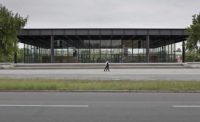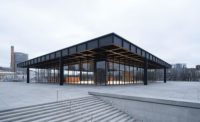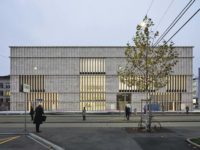Following a decade-long process involving highly concentrated phases of research, planning and construction, the Berlin office of David Chipperfield has completed the restoration of the Neue Nationalgalerie in Berlin, the last major work designed by Mies van der Rohe and opened in 1968. The striking building, with its immense steel roof seeming to float over a glass pavilion, was officially handed over to the client, the Stiftung Preußischer Kulturbesitz (Prussian Cultural Heritage Foundation), today.
Upon accepting the commission in 2012, the British firm approached the task with profound appreciation for Mies’ architectural vision and a deep respect for the modern art museum’s seminal role in the post-war revival of West Berlin. “It is a master work by a master architect, created in a very heightened atmosphere of duty to the city and the country,” says Chipperfield.
Chipperfield’s firm commenced the project with extensive archival research, supplemented by in-depth analysis of the building to identify problems and propose constructive strategies, and in 2018 the firm completed the second phase of the renovation project. The importance of the architecture, together with the complexity of the renovation, required input from not only the client and the museum direction, but also historic preservation authorities, engineers and technical experts. Because there were “no magic solutions,” says Chipperfield, his office developed a process to give weight to all concerns or “a methodology based on dialogue… to solve questions intelligently in a way that ensures everyone participates.”
As a result, much of the original building has been preserved, and 35,000 building parts were removed, refurbished and reinstalled. Innovative technologies were selectively introduced, such as the decision to keep the original lighting fixtures but converted to LED technology to reduce energy consumption and increase brightness. Other actions included the elimination of hazardous materials and the installation of new heating and ventilation systems. The façade glazing, however, was completely replaced with custom fabricated, single-glazed panels, each measuring roughly 11 by 18 feet. Discreet alterations, notably the addition of a ramp on the exterior and an elevator on the interior, will improve accessibility, while a 12,000-square-foot, below-grade extension, to accommodate the collection’s storage needs, will optimize the museum operations.
Currently bereft of contents, the freshly-restored Neue Nationalgalerie is an arrestingly elegant composition rendered in glass, steel and stone. “It is nice to see the building in its naked beauty,” says Chipperfield, “but let’s be clear: museums are best when they are filled with life and people!” Closed to the public since January 2015, the landmark is scheduled to open on August 21, 2021 with an exhibition of sculptures by Alexander Calder.










